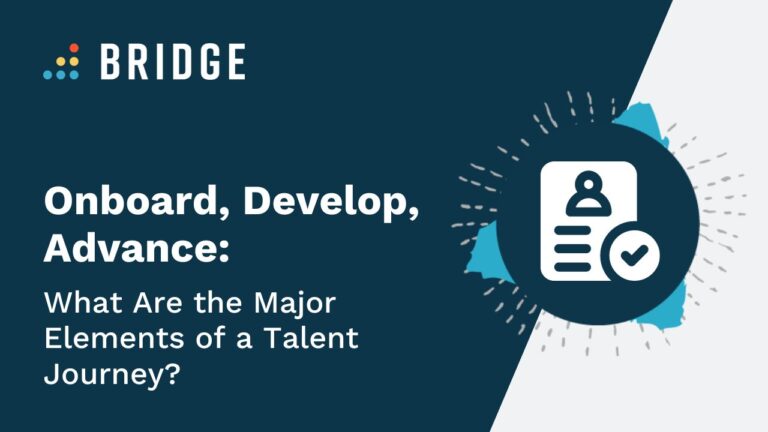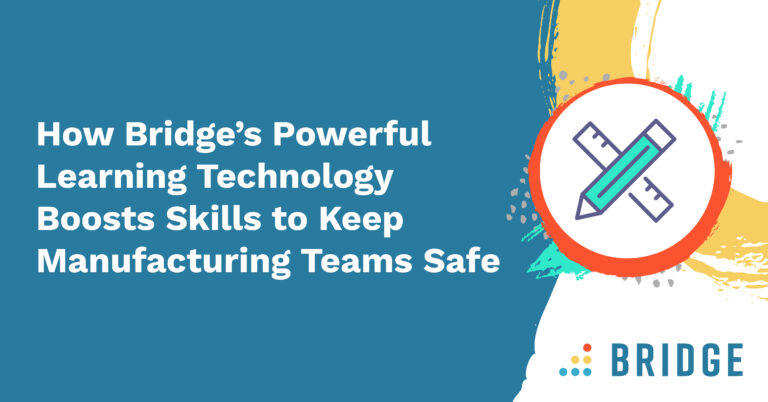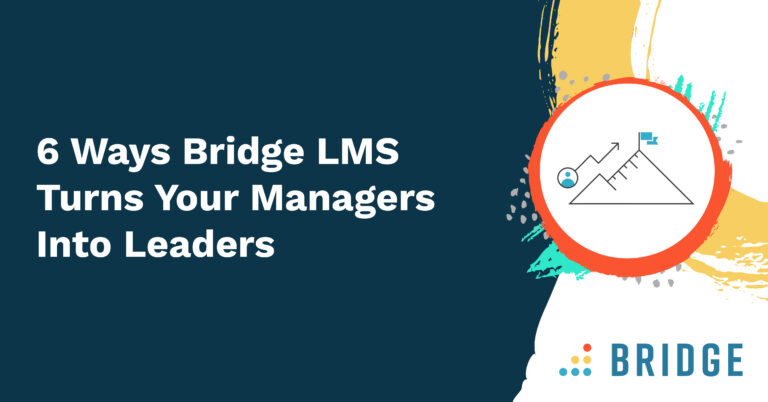Discover the considerations, practices, and learning management system (LMS) features you’ll need when you’re crafting the perfect talent journey.
It might be tempting to assume that talent journeys happen automatically. After all, the term refers to the total employee experience at your organization, from the moment a new hire joins to the moment they leave. But while that description might technically fit the definition, it omits a vast array of experiences and accomplishments that happen in between.Thankfully, the quality of these experiences is something you can actively control.
In other words: a good talent journey doesn’t just happen. It takes process design, tech infrastructure, and robust development opportunities to craft meaningful talent journeys that cater to both individual aspirations and organization-wide capability needs.
So, how do you give your people the growth, mobility, and support they need in order to flourish? Read on for the ins and outs of:
- Onboarding
- Development
- Advancement
- Assessment
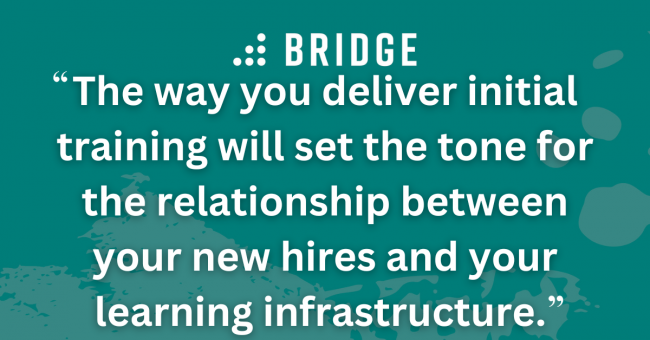
1) Start Your Talent Journeys on the Right Foot With Onboarding
While all organizations will have an onboarding process of one kind or another, not all onboarding is created equal. The way you introduce your organization to new hires will inevitably have an impact on those crucial early steps of the talent journey. In fact, a modest (but notable) 28% of organizations have improved their onboarding processes with a view to boosting their employee retention levels—pointing to the lasting effects of onboarding throughout the talent journey.
So, what makes a good onboarding experience? And how can you ensure that you deliver it?
Avoid Overwhelming Your New Hires
Onboarding describes an array of different ways to acclimate employees to their new positions. You’ll want to help them understand what your organization does, talk them through the ins and outs of your culture, get them up to speed on their mandatory training, introduce them to key colleagues, and so on.
But you don’t want to do all that at once.
Providing new hires too much too soon has been identified by the Chartered Institute of Personnel and Development (CIPD) as a key practice to avoid in the onboarding process, and for good reason. Nobody can absorb important information when it arrives as a deluge. Just as importantly, nobody benefits if your new hires wind up unable to remember vital compliance information because they were too busy juggling mandatory training with fun facts about the year your organization was founded!
This advice from the CIPD also has important implications for your talent journey. The way you deliver initial training will set the tone for the relationship between your new hires and your learning infrastructure. If you put your people off your LMS from the get-go, you might find they’re less inclined to return to it for those vital development resources that fuel advancement and propel them onto the next stages of the talent journey.
Space Out Your Onboarding Material With Learning Pathways
Avoid burying new hires under an avalanche of onboarding material by investing in an LMS with course chunking capabilities.
Features like our own Bridge Journeys will allow you to automate learning and development paths on a time-release basis. In an onboarding scenario, that might mean that new hires are offered, say, no more than one piece of relevant material per day for their first two weeks.
There are plenty of benefits to this approach. Automation means less work for your HR admins, and your new hires can acclimatize at a sensible pace. Plus, controlling the cadence of your content delivery also allows you to offer onboarding material in a variety of formats and media, secure in the knowledge that your new hires will experience each piece of content in the right order.
Crucially, this approach will start your organization’s talent journey off on exactly the right foot. Time-released content encourages learners to return to your learning ecosystem at regular intervals. Forming this habit at an early stage will make it all the easier to encourage your learners to continuously develop, grow, and advance throughout their journeys with your organization.
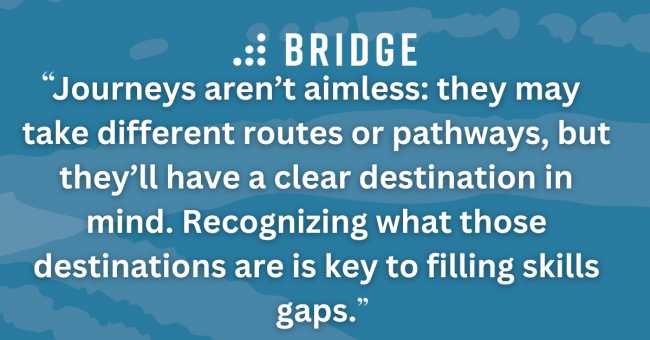
2) Add Precision and Encouragement to Your Employee Development Approach
Employee development is what makes a talent journey a journey. Without learning opportunities and the growth they represent, you’re not looking at a talent journey—just a talent gridlock.
It’s not just about learning, though. Journeys aren’t aimless: they may take different routes or pathways, but they’ll have a clear destination in mind. Recognizing what those destinations are is key to filling skills gaps.
Close Capability Chasms With Targeted Training
If you want a picture of the pitfalls that accompany less-than-targeted employee development initiatives, look no further than the World Economic Forum’s Future of Jobs Report 2023.
Among the report’s respondents, only 41% of current workers completed training that bridged skills gaps: a 1% decrease when compared to the 2020 version of the report. So, what does this tell us? Has training suddenly stopped working? Possibly! But there are one or two more practical ways to interpret this data.
If a fairly sizable proportion of workers aren’t completing training that bridges skills gaps, they might simply be failing to complete their assigned training at all. Alternatively, it might be that these workers aren’t completing the right training. They could be completing assignments that aren’t giving them the skills they need to close any gaps in their current position, or that don’t prepare them with the skills they need to develop in order to fill roles within their organizations.
Whichever interpretation you place on this data, the answer is the same. Whether your learners need more motivation to complete their training or they need resources that speak to the skills they actually need, the development stage of your organization’s talent journeys will benefit from technology that recommends the right learning for the right people.
That’s the conclusion drawn by a number of McKinsey partners in a 2023 discussion of talent journeys. These analysts point to the power of matching learning needs to organizational capability requirements, especially when that process can be facilitated by artificial intelligence.
Bridge’s AI upskilling platform, Skills Plus, is an example of this technology in action. Drawing on a library of over 32,000 skills, the platform uses artificial intelligence to offer employees up-to-date skills recommendations based on their job titles. It then guides them toward learning that’s been auto-tagged with the skills in question, ensuring that training is linked to the skills your people need.
Energize and Engage Employees by Supporting Their Development
Closing skills gaps is absolutely a key organizational priority, but it’s not the only advantage of investing in the development stage of the talent journey. For many workers, the development aspects of their jobs determine whether they’re on a talent journey at all, or whether they’re stuck in a stagnant world of disengagement.
According to Gallup, employee engagement among under-35s decreased by four percentage points and active disengagement increased by four points between 2019 and 2022. This group reported feeling:
- Less cared about
- Not encouraged in their development
- Lacking in opportunities to learn and grow
- Negative about whether their opinions count
- Less likely to have a best friend at work
Looking at these categories, it’s striking that employee development appears twice. Employees want to be encouraged to develop, perhaps in the form of a supportive manager or a dedicated mentor figure, and they also want opportunities to learn and grow. These could take the form of training courses or even short-term projects in other areas of your organization, but the key takeaway here is that the development stage needs to itself be fully developed.
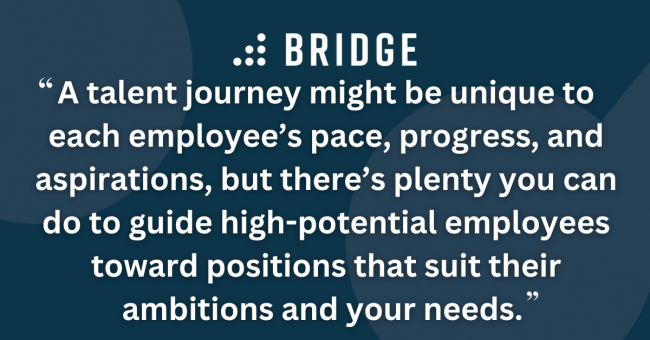
3) Propel Your People to New Heights With Rewarding Advancement Opportunities
If development opens up new pathways in an employee’s talent journey, advancement processes give them the green light to start walking. In a professional context, nobody learns just for the sake of learning—and by thinking about the practicalities involved in offering pathways toward advancement, you’ll have no trouble ensuring that your people’s development pays off.
Shape the Talent Journey With Talent Reviews and Succession Planning
In a world of capability gaps, the ability to recognize where different employees might slot into other roles within your organization is essential. A talent journey might be unique to each employee’s pace, progress, and aspirations, but there’s plenty you can do to guide high-potential employees toward positions that suit their ambitions and your needs.
As such, you’ll want to facilitate this stage of the talent journey through the use of talent reviews. A comprehensive and well-integrated performance management system will allow you to categorize and visualize employee potential, drawing from performance data like employee-manager 1:1s. With an all-in-one platform like Bridge by your side, you’ll also have a dedicated suite of L&D technology at your disposal—which means you’ll benefit from learning data, too, alongside the analytics tools that allow you to make sense of it all.
Combine this kind of technology with an AI-powered skills platform that recognizes the skills needs of every role, and you’ll have no trouble undertaking detailed succession planning. In short: you’ll be able to lend shape and strategy to the talent journeys of your employees.
MORE PERFORMANCE INSIGHTS | ‘Rethinking the 9 Box Talent Review’
Focus on the Wellbeing Aspects of Employee Growth
While filling capability gaps is a huge incentive for facilitating talent journeys, it’s not the only one. Advancement opportunities are also great for employee wellbeing—which is always something to strive for, both as a worthy goal in itself and for the positive business outcomes that follow.
The mental health benefits associated with growth and development opportunities have been spelled out in research from the American Psychological Association. According to one study, workers who lack growth opportunities are 24% more likely to feel stressed out during their workdays than those who do.
Just as importantly, respondents who were satisfied with their growth opportunities more often reported “good” or “excellent” mental health when compared to their unsatisfied counterparts. The differences were substantial, too, with 79% of satisfied respondents reporting good mental health versus just 52% of the unsatisfied group.
It goes without saying that employee wellbeing and satisfaction are goals worth pursuing in their own right—but it’s also worth noting the significant business case for taking every opportunity to bolster your workforce’s mental health. How do we know this? Well, according to one study, the key is to look at rates of sick leave. Higher levels of mental wellbeing are associated with lower productivity costs or losses because employees are taking less time off due to illness.
Even leaving aside the substantial capability-building implications of employee advancement, the presence of a strong talent journey up to and including the advancement stage clearly has positive implications for worker wellbeing and for your bottom line.
4) Keep Track of Employee Progress With Feedback and Assessments
The talent journey is an ongoing process. Advancement will rarely be the end goal, and that’s especially true when you encourage your employees to make lateral moves to exciting new disciplines, complete with fresh ladders to climb.
As your employees’ roles, goals, priorities, and skillsets shift in line with their individual talent journeys, they’ll benefit from various kinds of assessments. From frequent manager feedback to goals that’ll take employees to the next stages of their careers, this ongoing support is a great way to take stock of the milestones and aspirations that make up the best talent journeys.
MORE FROM THE BLOG | ‘Continuous Feedback: The Key to the Best Performance Reviews’
Provide Frequent Feedback
Nobody will be surprised to learn that feedback is associated with a range of positive outcomes. Take employee recognition, for example. Gartner research has shown that recognizing high-performance actions makes it 5.7 times more likely for employees to achieve optimal performance.
It’s not just about supplying this kind of feedback—it’s about supplying it in a timely manner. There’s a fantastic line in a 2022 Gallup report to this effect: the authors noted that “feedback has an expiration date,” and this observation is particularly worth bearing in mind when you’re fine-tuning your talent journey process.
After all, each talent journey your people travel will involve a constant drive toward new goals, new upskilling needs, and even new internal positions. Unless feedback is delivered promptly, it could quickly become irrelevant. As such, if you’re putting the talent journey front of mind when it comes to delivering feedback, you’ll be well advised to follow Gallup’s advice by offering continuous feedback that’s:
- Frequent
- Focused
- Future-oriented
Put Goals at the Heart of Your Feedback Culture
To implement this culture of continuous feedback, you’ll benefit from a performance management infrastructure that supports it. In particular, it’s worth keeping an eye out for a performance management system that makes it easy to set and recall goals. Combine good goal-setting features with a templated framework for your frequent 1:1 meetings, and you’ll quickly find yourself able to keep pace with your people’s journeys.
For bonus points, you’ll also want to ensure that your performance platform is fully integrated with your LMS. When your managers have access to their reports’ learning data, it’ll be easier to keep up with the milestones that characterize the talent journey—and to deliver that all-important recognition along the way.
ADOPT A GOAL-SAVVY MINDSET | ‘What Are SMARTER Goals and How Do They Help Measure Employee Productivity?’
Get the Detail on Every Step of the Talent Journey
This blog post is just a taste of our full ebook: “How to Reinvent, Reskill & Retain Your Employees With Talent Journeys.” Download the full ebook for more insights—or schedule a demo to discover how Bridge can take care of your employees from onboarding to advancement and beyond.
